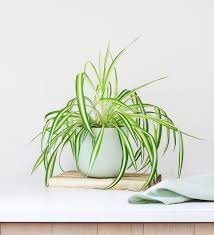Why Choose a Spider Plant?
Spider Plant is one of the world’s most popular houseplants for a reason. It is:
Easy to care for, even for beginners
Pet-friendly and non-toxic to cats and dogs
Air-purifying, removing toxins like formaldehyde and xylene
Visually striking, with green and white striped, arching leaves
Low maintenance, forgiving of occasional neglect
Its charming “spiderettes” (baby plants) dangle from long stems and make propagation fun and simple.
What Makes Spider Plant Attractive?
The most eye-catching part of the Spider Plant is its arch-shaped leaves with white or yellow stripes down the center. As the plant matures, it grows spider-like offshoots (“pups”) that hang gracefully, adding movement and beauty to your space.
Special Capabilities
Spider Plants are natural air cleaners. According to the NASA Clean Air Study (1989), they help remove: Formaldehyde, Xylene, Benzene (in some studies)
They’re also: Adaptable to low or bright indirect light, Safe for pets, Tolerant of inconsistent watering
Creative Ways to Display Spider Plants
-
In hanging baskets to showcase trailing pups
-
On floating shelves or windowsills
-
In glass containers or ceramic pots with modern decor
-
In terrariums or grouped arrangements with other tropicals
They thrive in any indoor aesthetic, from minimalist to boho
Repotting Essentials
Best Time to Repot
-
Season: Spring or early summer (when active growth begins)
-
Time of Day: Early morning or late afternoon (cooler, less stress)
Tools You’ll Need
-
New pot (with drainage holes)
-
Fresh, well-draining potting mix
-
Watering can or spray bottle
-
Trowel or scoop
-
Gloves
-
Pruning shears or scissors
-
Tray or saucer
-
Old newspaper or mat (for clean workspace)
Choosing the Right Pot
-
Materials: Ceramic, plastic, terracotta, or metal
-
Size: Slightly larger than current root ball
-
Drainage: Essential to avoid root rot
-
Style: Should match your decor and be easy to move and water.
Condition Requirement
Light Bright, indirect light preferred; tolerates low light
Watering Water when top inch of soil is dry; never soggy
Temperature 65°F–75°F (18°C–24°C)
Humidity 40–60%; mist in dry climates
Air Circulation Moderate airflow helps prevent pests & mold
Pest Signs & Control
Aphids Curling/sticky leaves → Use neem oil or insecticidal soap
Mealybugs White cotton-like clumps → Wipe with alcohol swab
Spider Mites Fine webbing, yellow specks → Mist more, apply miticide
Fungus Gnats Small flies near soil → Let soil dry, use sticky traps
Scale Insects Brown bumps on stems → Remove manually + horticultural oil
Prevention Tips:
-
Inspect new plants
-
Quarantine affected ones
-
Clean leaves regularly
-
Keep soil from staying soggy
Disease Signs Solution
Root Rot Yellow, wilting leaves; foul smell Trim roots, repot in fresh soil
Leaf Tip Burn Brown, crispy edges Use distilled water, reduce fertilizer
Powdery Mildew White powder on leaves Improve airflow, apply fungicide
Leaf Spot Brown/black spots, yellow halo Remove leaves, avoid overhead watering
Edema Blisters on leaves Reduce watering, increase airflow
Rust Orange/yellow pustules Remove affected leaves, treat with fungicide
Fertilizer Guidelines
Aspect Recommendation
Type Balanced 10-10-10 or 20-20-20 water-soluble fertilizer
Dilution Always use ½ strength to avoid leaf tip burn
Frequency Every 4–6 weeks during spring and summer
Winter Pause or reduce feeding (plant is dormant)
Organic Options Compost tea, fish emulsion, or worm castings
Tip: Use bottom watering for even absorption and less salt buildup.
Propagation Methods
Propagation by “Pups”
-
Cut baby plants from long stems
-
Place in water or directly in soil
-
In 2–3 weeks, roots form
-
Transplant to a small pot with fresh soil
Propagation by Division
-
Best for root-bound mature plants
-
Gently separate the root ball into sections
-
Repot each section separately
Propagation by Seed (rare)
-
Sow seeds in moist soil
-
Keep warm and bright
-
Germination may take weeks
Pruning & Maintenance
Task Details
When to Prune Anytime you see dead, yellow, or damaged leaves
Tools Needed Sharp, clean scissors or pruners
How Much Remove no more than 1/3 of the plant at a time
Cleaning Wipe leaves weekly to remove dust and pests
Extra Tip: Trim “pups” when the plant looks overcrowded or to encourage bloom.
Ongoing Maintenance Tips
-
Water consistently but avoid overwatering
-
Give it filtered sunlight—no harsh midday rays
-
Use light fertilizer in growing season
-
Mist or use a humidity tray if your air is dry
-
Repot every 1–2 years to refresh the soil and support root growth
Final Thought:
Spider Plants are beginner-proof, beautiful, and beneficial to your health. They clean the air, brighten your space, and multiply quickly—making them perfect for homes, offices, or anywhere you want a touch of green.
Whether you’re building your first indoor jungle or adding to your plant family, the Spider Plant is a smart, stylish, and sustainable choice.
Bring home a plant that gives back—choose the Spider Plant.

